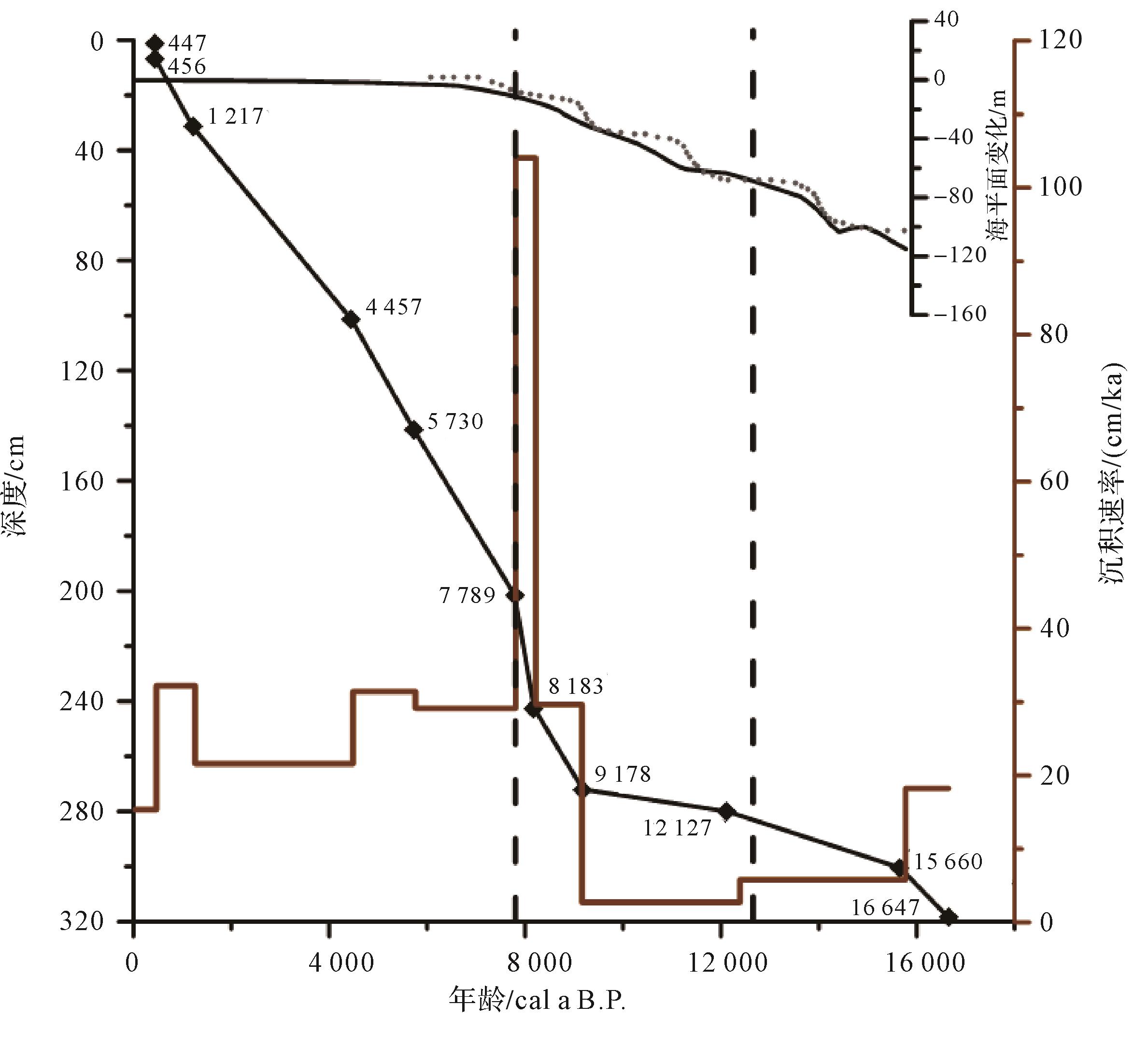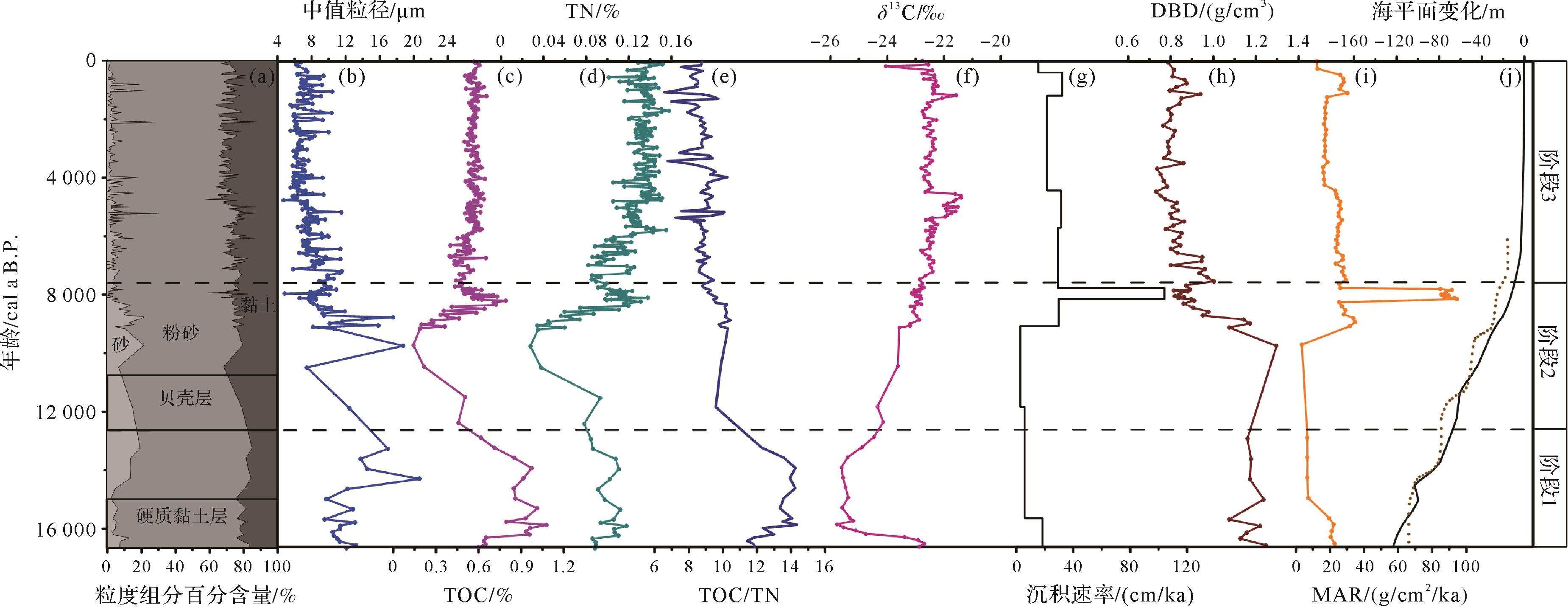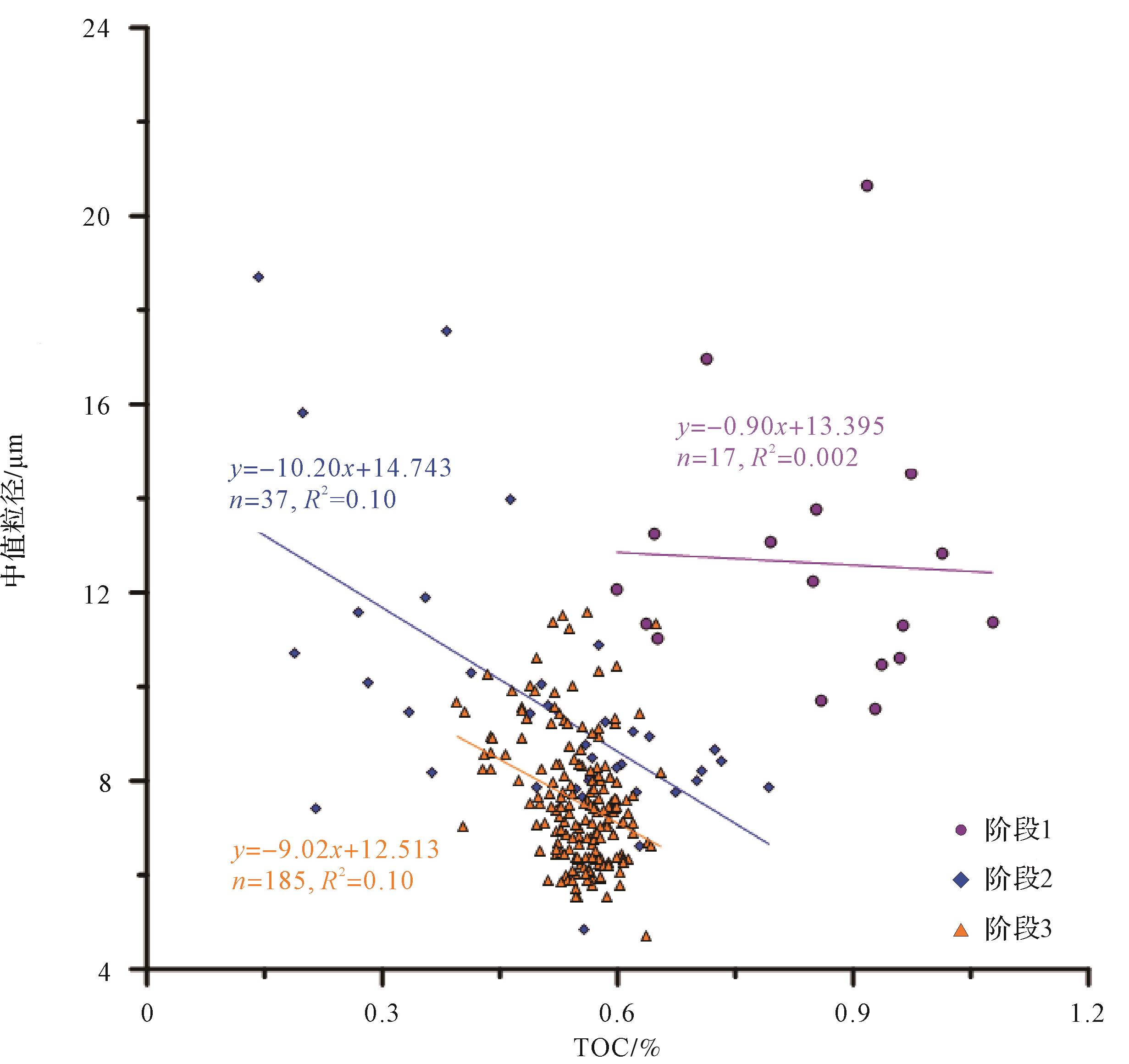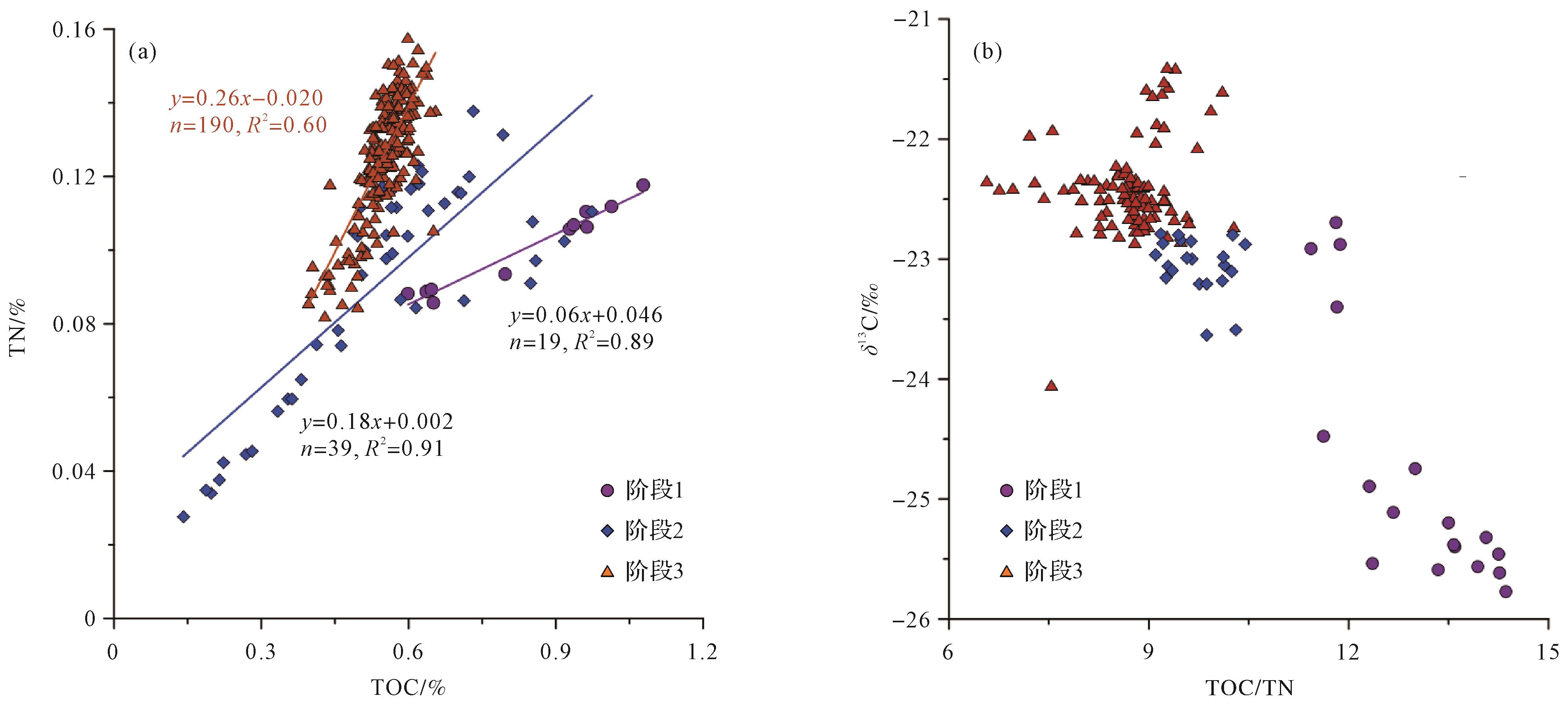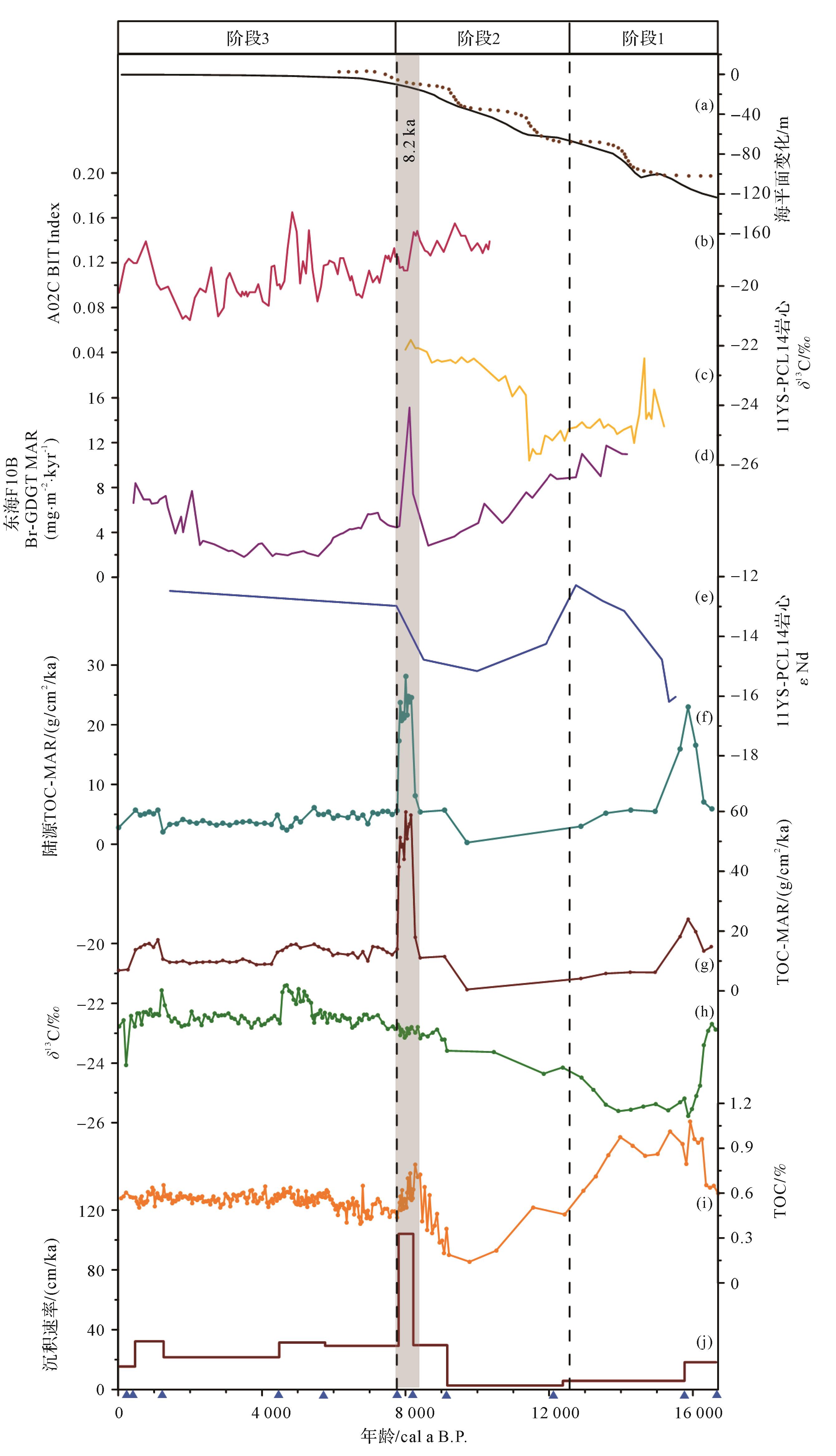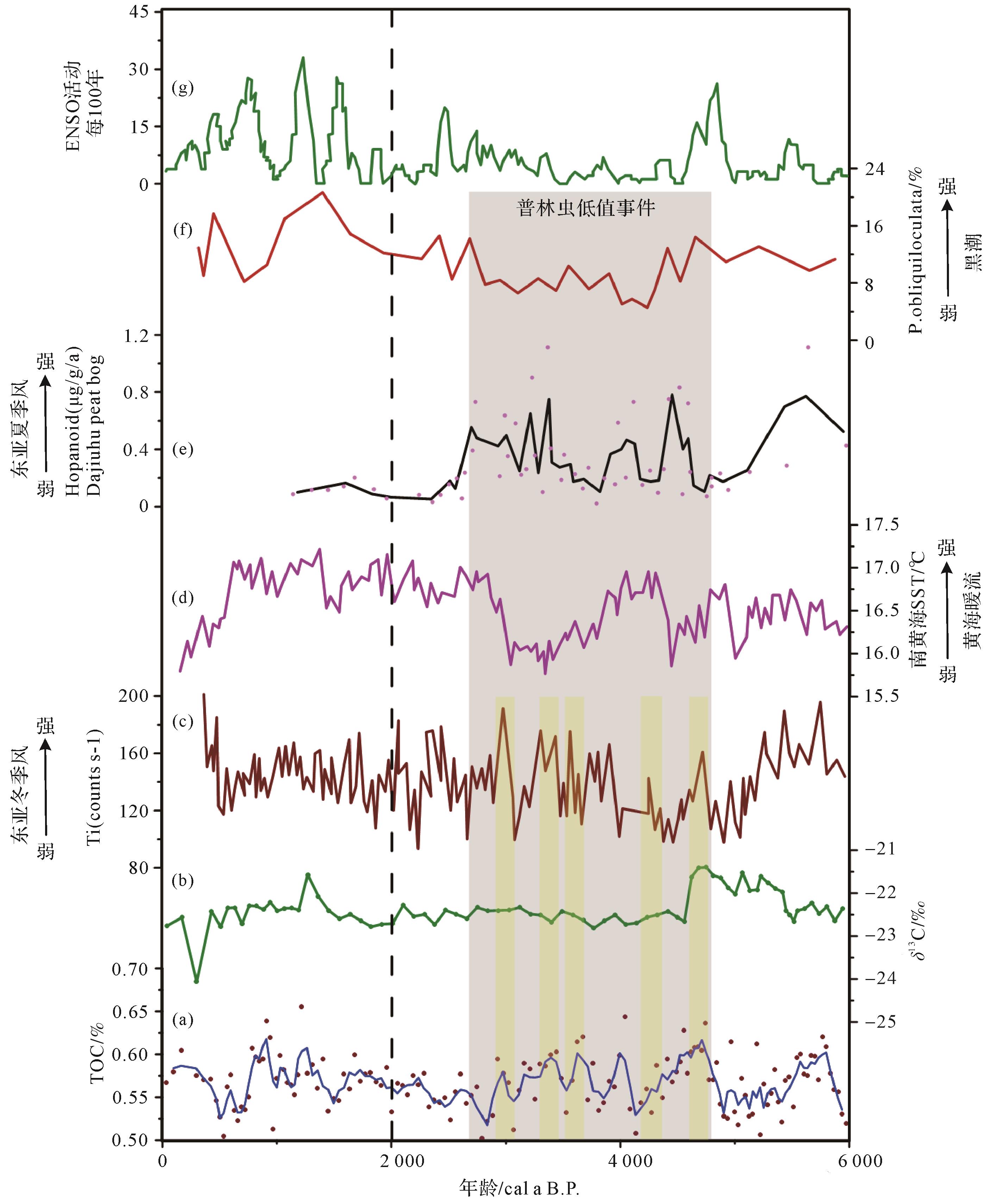HTML
-
海洋沉积物中长时间尺度的有机碳埋藏是仅次于硅酸盐风化的大气CO2汇,在气候的长期变化和碳的生物地球化学循环中具有重要意义[1]。陆架—边缘海地区是海陆相互作用的重要区域,贡献了全球80%以上的有机碳埋藏[2],对海洋碳循环发挥着重要作用[3]。这里不仅是河流颗粒物的重要沉积区,也是沉积有机碳发生堆积和埋藏保存的主要区域[4⁃5],是研究海平面变化、古气候和沉积物“源—汇”过程等环境变迁的天然“档案”[6]。中国东部陆架—边缘海受世界性大河(黄河和长江等)输入、复杂的环流体系、海平面波动,以及东亚季风等多重因素的共同影响,其沉积物和颗粒有机碳的源—汇过程及其环境记录可以反演地质历史时期的气候和海洋环境变化等信息[7⁃8]。
黄海位于中国大陆和朝鲜半岛之间,接受世界级河流(黄河、长江)和周边中小河流注入大量的陆源沉积物,在潮汐、波浪和洋流的共同作用下,高海平面以来发育了多个陆架泥质区[9⁃10]。其中,南黄海中部泥质区作为黄海最大的泥质区,具有初级生产力高、沉积速率快(最高可达2.7 mm/yr)[11]、有机碳含量丰富等显著特点;其沉积物不仅记录了高分辨率的古环境变化信息(海平面变化、海洋环流),还保存了古气候波动(东亚季风演化、黑潮演变、ENSO)的重要信息[12⁃14]。
20世纪80年代以来,众多学者对末次冰消期以来南黄海沉积物物源、沉积环境演化等方面展开系统研究,发现海平面变化作为一级控制因素,显著影响着沉积物供应和来源的变化[15⁃16],并导致有机质来源和埋藏效率也发生变化,随海平面上升,有机质来源发生了以陆源物质输入为主到海陆混合源的转变,且有机质含量经历了低海平面时期的高值到海平面上升时期的相对低值的变化[12,17];而陆源有机质的供应和埋藏还受到诸如河流输入、气候、水动力分选等因素的多重影响[18⁃20],表现为末次冰消期至全新世,陆源有机质含量有所下降[12]。也有学者从古气候演化方面对南黄海进行研究,发现千年尺度上东亚冬季风主导了黄海沿岸流和黄海暖流的强度,东亚冬季风增强,一方面会使黄海沿岸流将沉积在山东半岛北部的陆源物质再悬浮,导致较粗的沉积物输送至南黄海[13,21],另一方面会使黄海暖流将长江供应的陆源物质输送至南黄海,有利于促进海洋浮游植物生产力,进一步提高区域的海源有机碳埋藏通量[19];而在百年尺度上,有学者发现向南黄海输送的陆源沉积物主要受东亚冬季风驱动的“水动力分选效应”影响[18]。因此,东亚冬季风可以直接通过影响黄海沿岸流和黄海暖流,改变海洋上层水体环境和沉积动力条件,进而影响有机碳埋藏。研究发现,全新世晚期海洋初级生产力明显高于早期和中期,可能跟全新世晚期ENSO活动加剧有关[22],而最近的生物标志物证据则表明黄东海浮游植物生产力与东亚冬季风和黑潮驱动的海洋环流系统密切相关[19,23]。综上,前期对南黄海泥质沉积记录的研究大多集中于全新世高海平面以来的环境演化及其控制因素,相对缺乏末次冰消期以来海洋沉积物中有机碳埋藏演化记录,尤其是针对不同沉积环境演化阶段沉积有机碳的埋藏特征及控制因素的研究还相对较少。基于以上不足,本研究系统探究了南黄海中部泥质区末次冰消期以来的有机碳埋藏记录和海平面变化、古环境演变之间的阶段性差异响应,且利用高海平面以来(6 ka B.P.以来)高分辨率的总有机碳(TOC)含量变化探讨了高海平面时期以来,不同时间尺度有机碳埋藏的主要控制因素差异及其对气候环境变化的指示意义。
本研究以南黄海中部泥质区东侧的H12岩心为研究对象,结合高精度的年龄框架,主要分析了沉积物粒度、干容重、总有机碳、总氮(TN)及稳定碳同位素(δ13C)数据,结合周边已发表的多个岩心的地质环境记录(图1),旨在揭示末次冰消期以来南黄海中部有机碳埋藏演化特征及其控制机制,重点探讨海平面变化和高海平面以来不同时间尺度上中部泥质区有机碳埋藏的演化特征及其影响因素。
-
本文研究所用的样品来自2016年6月中国海洋大学的“东方红2”海洋综合调查船在南黄海中部泥质区东部边缘通过重力柱取样获得的H12岩心(35° N,124° E),岩心总长度319 cm,站位水深81 m。样品密封后送至实验室进行岩心拍照、描述、扫描及1 cm间隔进行分样,低温保存以供进一步分析。岩心底部约20 cm为硬质黏土层,276~283 cm为贝壳层,其余层位岩性整体较为均一,均为青灰色粉砂质黏土。
-
本文选取了11个层位的沉积物样品进行测年分析,分别在上部8个层位挑取了浮游有孔虫混合种、及下部贝壳层挑取了1个完整贝壳送至美国Beta实验室进行AMS14C测年。此外,在底部硬质黏土层选取两个层位(300~301 cm,318~319 cm)的样品进行有机碳14C测年,在青岛海洋科学与技术试点国家实验室同位素和地质测年平台完成(表1)。基于海洋校正数据库Marine20和区域碳储库年龄(∆R1=-272 ±31 a),利用CALIB8.20软件对原始14C年龄数据进行日历年校正,硬质黏土层的有机碳校正年龄使用IntCal 20(∆R2=0)。其中,∆R1是三个数据点的平均值,一个来自青岛[28],两个来自朝鲜半岛[29]。
样品编号 深度/cm 材料 惯用年龄 日历年龄(2σ) 实验编号 H12-1 1.5 浮游有孔虫混合种 730±30 447/(291~564) 520180 H12-2 7 浮游有孔虫混合种 740±30 456/(299~575) 520181 H12-5 31.5 浮游有孔虫混合种 1 550±30 1 217/(1 062~1 349) 520182 H12-9 101.5 浮游有孔虫混合种 4 200±30 4 457/(4 250~4 655) 520183 H12-11 141.5 浮游有孔虫混合种 5 270±30 5 730/(5 576~5 895) 520184 H12-13 201.5 浮游有孔虫混合种 7 240±30 7 789/(7 638~7 938) 520185 H12-14 242.5 浮游有孔虫混合种 7 620±30 8 183/(7 846~8 165) 520186 H12-15 272 浮游有孔虫混合种 8 430±30 9 178/(9 001~9 365) 520187 H12-16 280 贝壳 10 580±30 12 127/(11 890~12 408) 520188 H12-300-301 300~301 有机碳 13 070±150 15 660/(15 223~16 101) — H12-318-319 318~319 有机碳 13 740±160 16 647/(16 167~17 074) — Table 1. Age control points of core H12
-
用直径为2.36 cm、高为0.98 cm的容重环对H12岩心以4 cm为间隔共取了78个样品,将样品冷干后再烘干,称重,所得干样重除以容重环的体积,得到干容重(DBD,单位:g/cm3)。总埋藏通量(MAR)是通过线性沉积速率(LSR)和干容重计算得到,即:MAR(单位:g/cm2/ka)=LSR×DBD。
-
选取245个样品进行粒度分析,在自然资源部海洋地质与成矿作用重点实验室完成。取0.2 g沉积物分别在15 mL H2O2(15%)和5 mL HCl(10%)中浸泡24 h,以去除有机质和碳酸钙,离心洗酸直至pH=7。测试仪器为英国Malvern 3000激光粒度分析仪,测量范围为0.02~2 000 μm,粒级分辨率为0.01 Φ。粒度参数采用矩法进行计算,沉积物分类和命名采用谢帕德分类命名法。
-
选取249个样品进行有机碳氮分析,在自然资源部海洋地质与成矿作用重点实验室完成。样品研磨之后,取1 g左右的沉积物置于50 mL离心管中,滴加1 mol/L的盐酸进行酸化,之后加Milli-Q水离心直至上清液至中性,60 ℃烘干样品。取20~30 mg去除碳酸盐样品包于独立的锡舟中,利用元素分析仪EA Vario EL Ⅲ上机测试,相对标准偏差均小于0.05%。
根据有机碳氮的垂向变化,选取了142个样品进行稳定碳同位素测试,在中国海洋大学海底科学与探测技术教育部重点实验室完成。取5~15 mg去除碳酸盐后样品置于锡杯中,包好置于稳定同位素质谱仪上进行测试(质谱仪为Delta 253 plus,元素分析仪(EA)为EA-Isolink Flash 2000HT)。其中,EA工作炉温为980 ℃,色谱柱温为65 ℃,载气流速:180 mL/min,氧喷条件为250 mL/min,注氧时间为5 s。采用国际标准物质USGS64、USGS40、LA-R006作为参考工作标准。测试精度约±0.08‰。
-
在此次研究中,使用二端元混合模型来大致评估海陆源有机质在沉积物中的相对贡献。海源有机碳δ13C的变化范围相对较小,通常介于-19.0‰~-21.0‰[30]。中国边缘海海洋生物群的δ13C平均值为-20.9‰[31],海源有机碳的δ13C平均值为-20.0‰[32],取二者平均值-20.5‰作为海源有机碳的δ13C端元值。由于南黄海中部泥质区沉积物中陆源有机质主要来自黄河和长江[33],且在整个华北地区陆地C3植物占主导地位[34]。因此,参考陆地C3植物的δ13C值(平均值为-27.0‰)[35],黄河颗粒有机碳的δ13C端元值(-24.0‰)[36⁃37],长江颗粒有机碳的δ13C端元值(-26.0‰)[38],取三者平均值为-25.7‰作为陆源有机碳的δ13C端元值。
δ 13C=δ 13Cter×Fter+δ 13Cmar×Fmar(1) Fter+Fmar=1 (2) 式中:δ13C为样品实测的δ13C值,δ13Cter为陆源有机碳的δ13C端元值,δ13Cmar为海源有机碳的δ13C端元值,Fter为陆源贡献比,Fmar为海源贡献比。据此,进一步计算得到H12岩心海陆源有机碳含量和埋藏通量[39]。
1.1. 样品来源
1.2. AMS14C测年
1.3. 干容重分析
1.4. 粒度分析
1.5. 有机碳氮及其稳定碳同位素(TOC、TN及δ13C)分析
1.6. 有机质二端元混合模型
-
根据有孔虫/贝壳AMS14C和TOC-14C测年数据,确定了11个年龄控制点,测年结果如表1和图2所示,恢复H12岩心底部319 cm处年龄为16 647 cal a B.P.,距离岩心顶部1.5 cm处样品的年龄为447 cal a B.P.,使用线性内插/外推法获得了整个岩心的年龄框架。岩心总体上包含了从末次冰消期至全新世的连续沉积,平均沉积速率为31.5 cm/ka。
-
图3展示了大约17 ka B.P.以来沉积岩心的粒度、有机碳氮及其埋藏通量的变化曲线,并与海平面变化曲线进行对比[40⁃41],具有明显的阶段性响应,分别为:相对低海平面时期(阶段1,319~283 cm,17~12.6 ka B.P.)、冰消期海侵期(阶段2,283~203 cm,12.6~7.8 ka B.P.)和冰消期高海平面时期(阶段3,203~0 cm,7.8 ka B.P.以来)。

Figure 3. Vertical distribution of particle size composition (a), median grain size (b), total organic carbon (TOC) (c), total nitrogen (TN) (d), carbon to nitrogen ratio (TOC/TN) (e), organic carbon isotopic composition (δ13C) (f), sedimentation rate (g), dry bulk density (h), and Mass Accumulation Rate (MAR) (i) in core H12 and comparison with sea level change[40⁃41]
H12岩心整体以粉砂为主,下部砂质较为丰富,上部黏土增多(图3a)。沉积物主要为粉砂(54.03%~81.63%,平均值为68.62%),其次为黏土(10.57%~42.21%,平均值为26.42%)和砂(0~30.19%,平均值为4.89%)。中值粒径的变化范围为4.70~20.66 μm,平均值为8.24 μm(图3b)。相对低海平面时期发育一硬质黏土层,粒度较粗,中值粒径介于9.55~20.66 μm,平均值为12.63 μm;冰消期海侵期由于沉积环境发生变化,粒度波动较大,中值粒径介于4.85~18.72 μm,平均值为9.66 μm;高海平面时期粒度较为稳定,中值粒径介于4.70~11.57 μm,平均值为7.54 μm。
TOC介于0.14%~1.08%,平均值为0.56%(图3c)。相对低海平面时期,TOC含量最高,介于0.60%~1.08%,平均值为0.83%;冰消期海侵期,TOC含量波动较大,从0.46%降低至0.14%,又升高至0.58%,平均值为0.50%;高海平面时期,TOC含量稳定保持在0.40%~0.66%,平均值为0.55%,且6 ka B.P.以后,TOC含量出现明显规律性波动。通过对H12岩心沉积物粒度和TOC含量的相关性分析发现,阶段1和阶段3的TOC含量与中值粒径相关性均较低,而两者在阶段2呈现一定的负相关(相关系数R2=0.36)(图4)。
TN介于0.03%~0.16%,平均值为0.12%(图3d),其变化趋势与TOC相似。相对低海面时期,TN的含量介于0.08%~0.12%,平均值为0.10%;冰消期海侵期,TN含量较低,变化范围为0.03%~0.14%,平均值为0.09%;高海面时期TN整体处于较高水平,变化范围为0.08%~0.16%,平均值为0.13%。
H12岩心的沉积速率介于2.7~104.1 cm/ka,在7.8~8.2 ka B.P.之间沉积速率出现异常高值,约为104.1 cm/ka(图3g)。干容重介于0.73~1.30 g/cm3,平均值为0.89 g/cm3(图3h)。埋藏通量(MAR)介于3.5~94.6 g/cm2/ka,平均值为30.5 g/cm2/ka(图3i),其变化趋势与沉积速率基本一致。
-
TOC/TN介于6.56~14.35,平均值为9.42(图3e)。TOC/TN值在相对低海面时期较高(11.43~14.35,平均值为12.98),随海平面上升,其值从10.44降低至9.11(平均值为9.72);高海面时期,TOC/TN偏低,介于6.56~10.28,平均值为8.71。
δ13C值介于-25.77‰~-21.40‰,平均值为-22.83‰(图3f),其变化趋势基本上与TOC/TN的变化相符。相对低海面时期,δ13C偏负,介于-25.77‰~-22.70‰,平均值为-24.78‰,陆源贡献比介于40.0%~95.9%,平均值为77.7%;冰消期海侵期,δ13C逐渐偏正,从-24.35‰升高至-22.79%,陆源贡献比介于41.6%~56.9%,平均值为46.3%;高海面时期,δ13C值介于-24.06~-21.40‰,平均值为-22.41‰,陆源贡献比介于16.3%~43.0%,平均值为34.4%。
2.1. AMS14C测年
2.2. 粒度特征和有机碳埋藏通量
2.3. TOC/TN和δ13C
-
南黄海中部沉积物受周边黄河、长江和韩国河流输入的共同影响,年输沙量近1.6×109 t,其中黄河、长江各占68%和31%[42]。受海平面影响,末次冰消期以来南黄海的沉积环境演化经历了相对低海平面时期—冰消期海侵期—高海平面时期[33]。其中,相对低海平面时期,沉积物粒度较粗,具有较高的沉积速率,硬质黏土层中的TOC含量、TOC/TN均出现高值[12],表明大量陆源物质涌入南黄海,结合地震剖面证据,发现低海面导致陆架暴露,研究区沉积物受到老黄河直接流入的影响最大;冰消期海侵期,粒度逐渐变粗,老黄河与研究区之间的距离逐渐增加,地球化学证据指示沉积物主要来源于韩国西部河流;高海平面时期,黏土矿物和地球化学组成均指向长江影响为主,受黄河和韩国河流影响较小[43],黄海暖流形成于6.5 ka B.P.左右[44],细粒物质可沿黄海暖流路径携带至研究区。因此,不同沉积环境的演化阶段导致沉积物物源供应和沉积动力环境显著不同,这可能对有机碳的来源和埋藏记录有直接的影响[12,25,45]。通过分析沉积物粒度与TOC含量之间的相关性(图4),发现相对低海面时期和高海面时期的TOC含量与中值粒径之间相关性很低,说明TOC含量变化几乎不受沉积物粒度影响。
TOC/TN广泛应用于指示边缘海不同来源有机碳的相对贡献[35,46]。根据前人研究,海源有机碳的TOC/TN值一般介于5~7,陆源有机碳TOC/TN值大于15[35,47]。然而,陆架边缘海沉积环境活跃,水动力强,尤其是受到河流输入的影响,会不同程度地影响其对有机碳来源的识别。H12岩心TOC/TN值介于6~15,整体为海洋和陆源的双重影响[12,17,19](图3e)。三个时期的TOC和TN之间存在较好的相关性(图5a),指示H12岩心沉积物中的有机质来源较为一致;无机氮含量大体介于0.002%~0.05%,考虑到TN含量介于0.03%~0.16%,因此无机氮的赋存(例如黏土矿物的吸附)不可忽视。相比之下,有机质的δ13C值受到成岩和后期改造的作用较小,是识别沉积有机碳来源的一个相对更加可靠的指标[30,48⁃49]。一般来说,海源有机碳的δ13C介于-19‰~-21‰[30],陆地C3植物的δ13C介于-22‰~-33‰,陆地C4植物的δ13C介于-9‰~-16‰[49]。相对低海平面时期的δ13C值偏负(平均值为-24.47‰)(图5b),反映陆源有机碳输入为主,这可能与该时期陆架暴露有关;而冰消期海侵期和高海平面时期δ13C值明显偏正,以海洋有机碳贡献为主[12,17,50]。
-
相对低海平面时期(阶段1,17~12.6 ka B.P.):岩心底部发育硬质黏土层,粒度较粗,TOC含量较高,δ13C值偏负,TOC埋藏通量介于6.85~17.06 g/cm2/ka,平均值为12.09 g/cm2/ka。低海面时期,硬质黏土层的发育在长江三角洲和东部陆架海曾有报道[51⁃52],如硬质黏土层作为长江三角洲地区的标志性沉积,属河漫滩沉积[53];也有研究认为其形成时为冷干的温带气候且干湿季节交替明显,可能是风成堆积物(形成时间可能介于25~12 ka B.P.)[51,54⁃55]。北黄海中部硬质黏土层的孢粉证据表明该黏土层主要形成于海平面暂时停滞或回落且寒冷而湿润的淡水环境,且与新仙女木事件相吻合[56]。研究显示,相对低海面时期古河道是沉积物运输的重要途径[57],此时众多古河道(古黄河—朝鲜河流)在南黄海汇合[58⁃59],可能为本研究区提供了丰富的陆源沉积物[57],导致该时期相对较高的有机碳埋藏通量。
冰消期海侵期(阶段2,12.6~7.8 ka B.P.):岩心沉积物粒度逐渐变细,TOC含量偏低,并随着海平面的升高呈阶段性下降,TOC埋藏通量介于0.50~59.78 g/cm2/ka(图6g)。与相对低海面时期相比,该时期TOC含量显著降低,δ13C值相对偏正,反映沉积动力环境较强和海源有机碳贡献升高(图5a,b)。由于这一时期的老黄河口位置偏北,黄河物质主要集中在山东半岛北部[60],可能导致该时期沉积速率较低。随着海平面上升,强潮流造成大量沉积物侵蚀[61],可能给该区贡献了较粗的沉积物[62],反映了南黄海末次冰消期沉积环境和有机碳的埋藏变化直接受控于海平面变化。不过,值得注意的是,陆源TOC埋藏通量在~8 ka B.P.左右出现了明显高值(图6f),与东海陆源有机质沉积记录相一致[26](图6d)。并且,同时期黄海表层海水温度(SST)明显下降,东亚冬季风显著增强[63⁃64],这与“8.2 ka B.P.”降温事件一致[14],可能表明全新世北大西洋和西北太平洋之间通过东亚冬季风存在遥相关关系[65],而冬季风的增强可能通过影响沿岸流改变了陆源有机质输送和埋藏方式[18]。

Figure 6. Comparison of the organic carbon burial record in core H12 with sea level changes over the past 17 ka B.P.
高海平面时期(阶段3,7.8 ka B.P.至今):沉积物粒度较细,TOC含量相对稳定,有机碳埋藏通量在6.85~17.06 g/cm2/ka之间变化,与冰消期海侵期相比,有机碳埋藏通量降低了44%。研究显示,高海面形成后黄海的古海洋条件与现代相似,陆源物质入海的距离增加,陆源有机质减少[10]。此外,基于黏土矿物和地球化学证据表明8 ka B.P.以来南黄海中部沉积物(YSC-1岩心和11YS-PCL14岩心)主要来源于长江[16,33]。长江冲淡水供应的细粒物质可沿黄海暖流路径向北输送至南黄海中部,在弱潮流和气旋涡流动力条件下形成稳定的泥质沉积,也利于有机质的沉积埋藏。另一方面,海洋锋(黄海沿岸流和黄海暖流相遇形成的温盐锋)和强沿岸流的屏障效应可能也限制了黄河和韩国西部河流沉积物进入南黄海中部[66]。
-
全新世高海面以来南黄海的沉积环境复杂,有机碳来源多样[19,50]。海源有机碳主要受上层水体浮游植物生产力控制[67];而陆源有机碳主要由南黄海周边河流提供[20⁃21]。东亚季风、黄海暖流和黑潮等深刻影响着该区的水文环境,并对海洋生产力和陆源物质供应有直接的作用[68]。通过对本区6 ka B.P.以来的有机碳沉积记录的高分辨率分析,结合泥质区不同位置的重建记录及区域气候演化趋势,发现6 ka B.P.以来该区TOC的埋藏大致可分为两段。
(1) 6~2 ka B.P.期间,有机碳含量呈规律性波动,且幅度相对较大(相对标准偏差为0.57%±0.06%,图7a),δ13C由偏正转为偏负(图7b)。对比发现TOC的整体变化与SST较为一致,即高SST时对应较高的TOC含量,这可能表明温度对海洋初级生产力有较大影响,该区TOC可能更多地反映了海洋源有机质的供应。而且,该阶段(5~2 ka B.P.)TOC含量在百年尺度上变化幅度较大,与黑潮强度减弱的时期基本一致,整体上TOC含量的高值对应于东亚冬季风的强盛期,可能反映了冬季风驱动下黄海暖流的增强导致海洋初级生产力以及水体环境的变化,进而影响了TOC的埋藏特征。考虑到本研究使用的H12岩心位于黄海暖流向北入侵的路径上,TOC含量变化可能受到与黄海暖流相关的海洋过程的直接影响,前人研究已发现7~5 ka B.P.黄海暖流入侵南黄海,使得输入到研究区的营养物质增多,促进海洋生产力增加[19],且这一时期的黄海冷水团底层年平均水温小于8 ℃,沉积环境偏还原(氧化—还原电位-30~-150 mV)[69⁃70],可能也有利于有机碳的埋藏保存。此外,发现该时期TOC较大的变化幅度与东亚冬季风和东亚夏季风处于相互作用的转换阶段一致[71],也可能反映了区域气候条件的不稳定性对TOC埋藏的制约。
(2) ~2 ka B.P.之后,TOC波动性较之前显著下降且趋于稳定,海洋源有机碳的贡献显著升高。研究表明,该时期东亚冬季风和东亚夏季风强度均较弱[64,72](图7c,e),SST整体偏高但变化幅度也较小[14](图7d);此阶段黑潮的增强可能提高了该区的海洋生产力[23,73](图7f),黄海暖流带来了更多的陆源物质[14],总体可能有利于该区有机碳的沉积[60]。从流域的角度,也有研究表明,2~3 ka B.P.以来更频繁且更强的ENSO事件引起长江流域发生暴雨或者洪水(图7g)[74],加强了长江冲淡水的流动,可能导致研究区的营养物质供应增加,从而提高了海洋生产力[75],进而有利于本区有机碳的供应和埋藏。
3.1. 末次冰消期以来南黄海中部沉积有机碳埋藏演化
3.1.1. 沉积环境演化与TOC来源
3.1.2. 末次冰消期以来黄海中部有机碳埋藏的阶段性演化
3.2. 全新世高海面以来有机碳的沉积记录及其指示意义
-
末次冰消期以来海平面变化是南黄海沉积环境和有机碳埋藏演化的重要控制因素,相对低海平面时期有机碳埋藏通量(12.09 g/cm2/ka)较高,以陆源有机质输入为主,可能与众多古河道的发育有关;冰消期海侵阶段TOC来源是以海源有机质为主的海陆混合源,随着海平面的上升,潮流侵蚀等动力作用增强,陆源有机碳贡献不断降低;8 ka B.P.左右,陆源TOC埋藏通量出现显著高值(22.80 g/cm2/ka),与东亚冬季风显著增强和全球降温事件相对应,可能与季风驱动下沉积物的输送方式改变有关;高海平面时期以海源有机质贡献为主,东亚季风的变化以及黄海环流体系的形成可能对全新世以来有机碳的沉积埋藏产生重要影响;特别是中晚全新世以来(大约5~2 ka B.P.),TOC含量相对变化幅度较大,与东亚冬季风和表层水温SST变化较为一致,可能反映了东亚冬季风影响下的黄海暖流为主导的海洋初级生产力以及水体环境变化对TOC埋藏的影响。~2 ka B.P.以来TOC变化幅度减小,海源有机质贡献整体增加,可能与ENSO活动的加强有关。

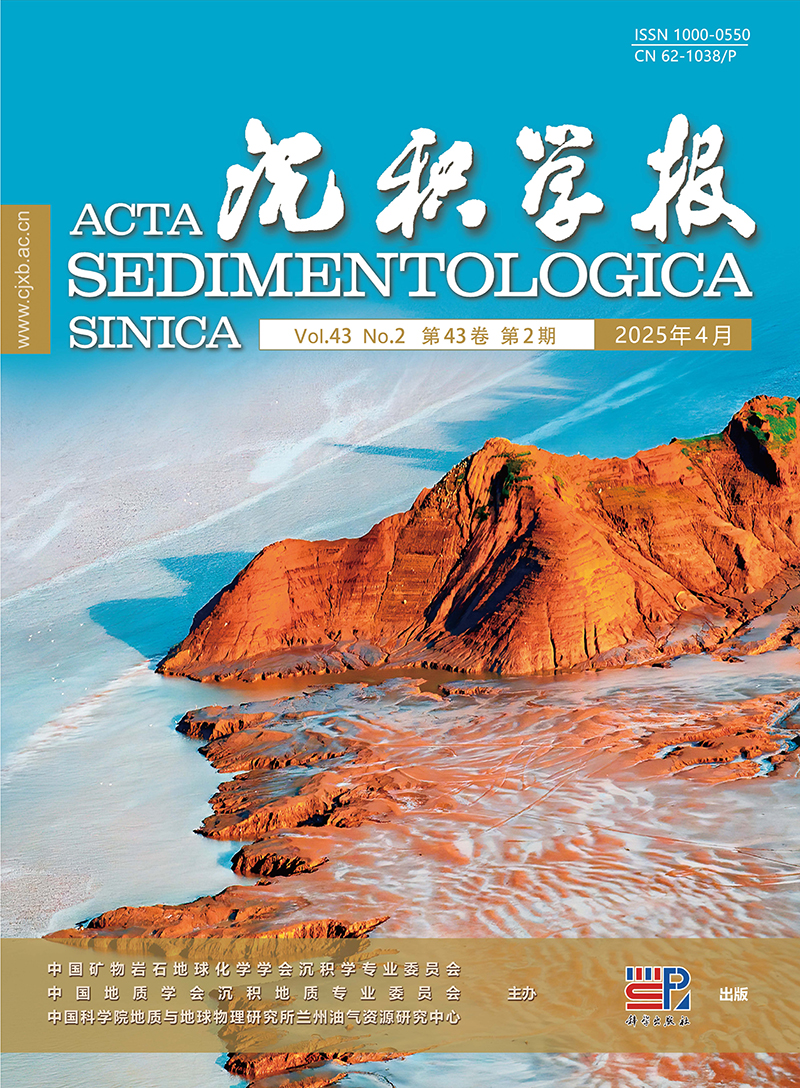


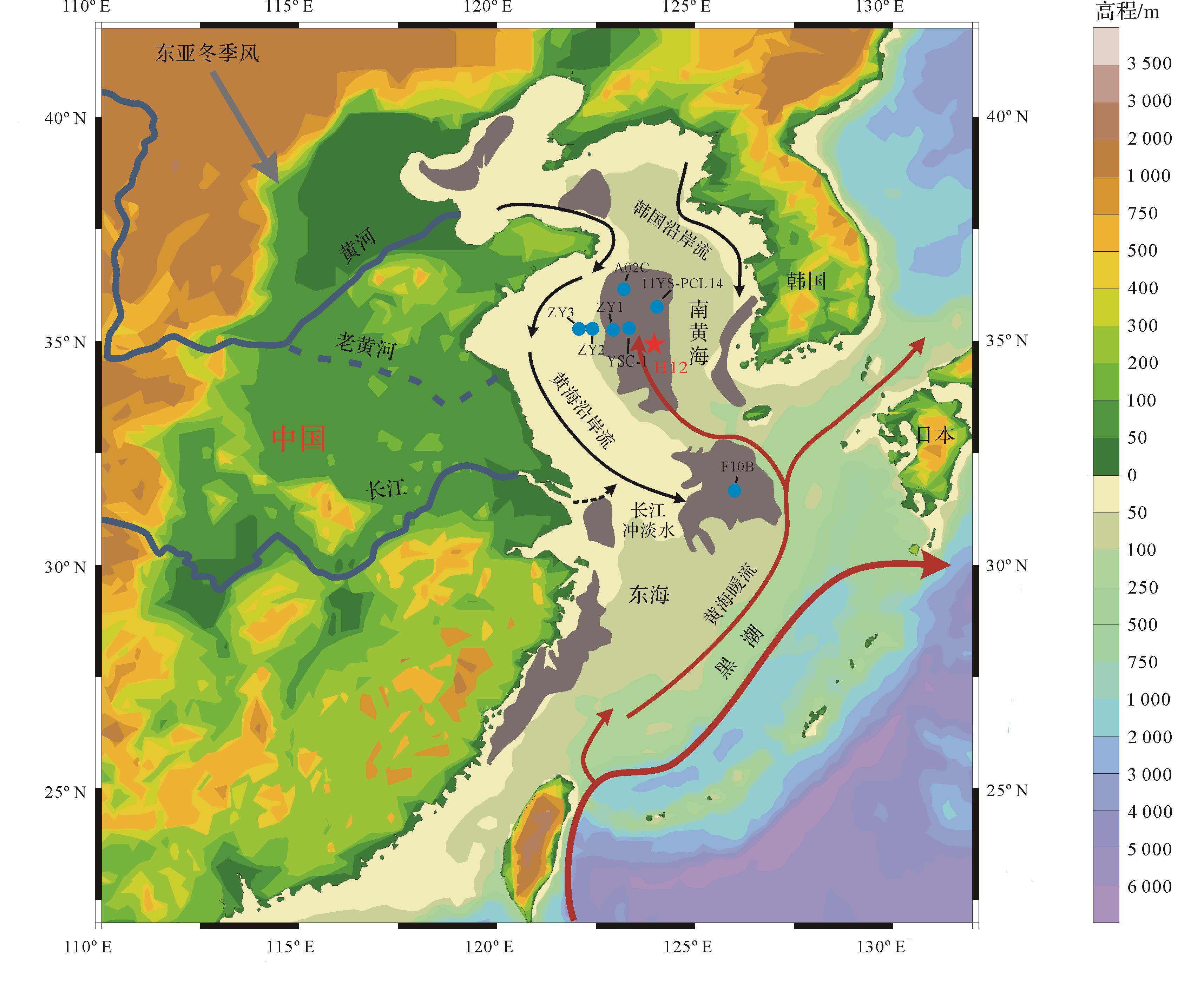







 DownLoad:
DownLoad:
